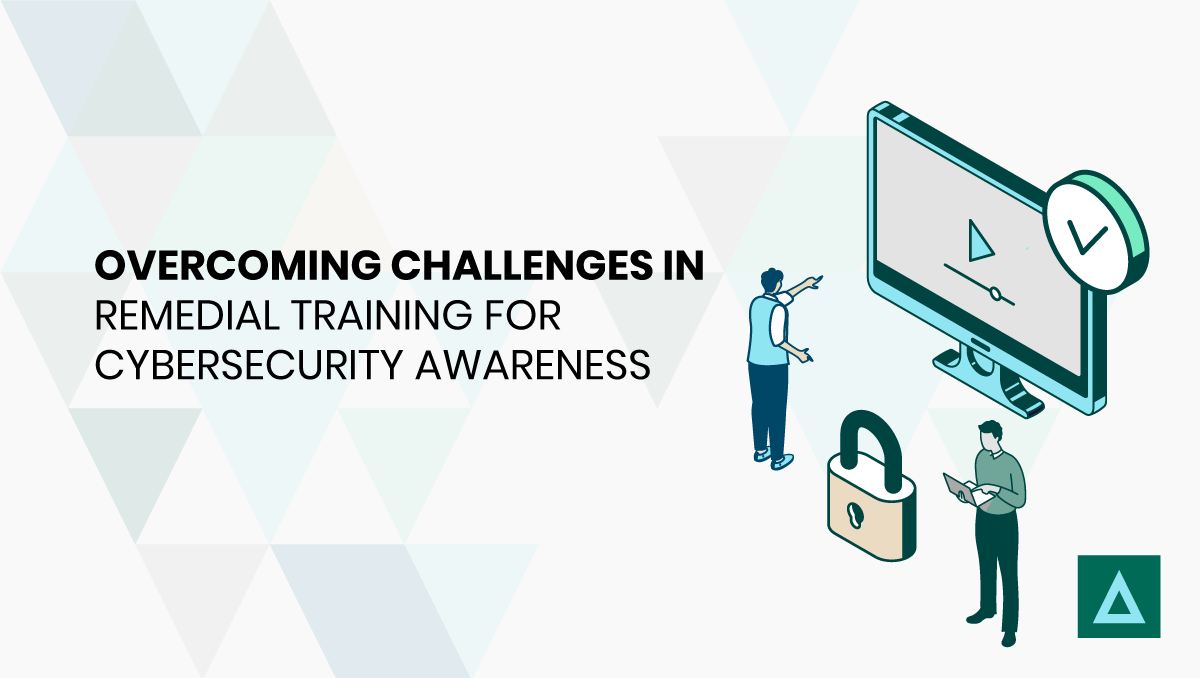Remedial training is a type of training specifically focused on individual employees who struggle to understand and abide by specific cybersecurity concepts. While this type of training can be very beneficial, it has a few pitfalls that must be dealt with to get results.
This article will explain the most common challenges of remedial training programs and provide helpful tips to overcome them.
Identifying Common Challenges in Remedial Training
Once you identify repeat clickers and employees with inadequate knowledge, remedial training is an essential component of any cybersecurity awareness strategy. Unfortunately, achieving success for this type of initiative can be much more difficult than other cybersecurity training.
Here are the most common reasons:
Employee Resistance and Disengagement
One of the biggest enemies of cybersecurity training is low employee engagement, which has dramatic impacts on compliance and overall knowledge levels. It’s often the result of three situations:
Fear of stigmatization or even a fear of being fired if their score results are low. Remedial training must be presented in a positive, encouraging way to avoid this.
Boring content inevitably leads to disengaged employees who view the training as a chore rather than a learning experience. To combat this situation, it is essential to have a variety of content and formats that will engage different audience members.
Lack of relevance is the sign of a poorly optimized training program that should have better segmentation and targeting to provide pertinent training to their audiences.
Time Constraints
One of the core metrics you need to determine for remedial training is your organization’s training tolerance. One way this is manifested is through the time executives are willing to allocate to cybersecurity training.
In certain industries, like healthcare, this time allocation can be as low as 10 minutes per quarter. It’s hard to justify cybersecurity training to employees busy with mission-critical tasks or literally saving lives, like doctors and nurses.
But high-stress industries like healthcare also see a lot of ransomware and phishing attacks, specifically because hackers exploit the stress level, which culminates in more errors from employees. At the end of the day, there must be a balance in time allocation, especially when the impact of a data breach can shut down operations or result in the leak of sensitive data.
Tailoring Training to Diverse Needs
One common issue with training is employees' short attention span. Microlearning can address this by delivering short, regular lessons on specific areas where the employee struggles. The recurring nature of these modules also provides more data to track progress and make future adjustments.
An added benefit of micro and nanolearning is that it accommodates high-stress, low-availability environments by promoting convenience.
Larger organizations might also face a language barrier when deploying global cybersecurity remedial training programs. To increase completion rates, it’s ideal to have all cybersecurity modules in as many translations as possible.
Measuring Training Effectiveness
Cybersecurity training can’t be done in a vacuum; it must be paired with a robust data collection and analysis process. Deciding which KPIs to follow is personal to each organization, but here are the ones that are most commonly used:
Click rate is the essential base metric for allocating remedial training. For almost any organization, a click on a phishing link is a potential disaster that should be corrected.
Security Awareness Index is an aggregate score of all activities done within the training programs, like course and quiz completion rates, course grades, and whether they are set to pass future phishing simulations. This index will give those users a score to evaluate their risk level and vulnerabilities.
Reporting rates can be monitored to determine whether users are accessing a dangerous site and reporting phishing emails regularly. This data can be used standalone or added to the above index for better accuracy and risk assessment.
Strategies to Overcome Challenges
Overcoming the obstacles in cybersecurity training requires innovative approaches. By adopting creative strategies, organizations can enhance engagement and motivation among employees.
Enhancing Engagement and Motivation
Cybersecurity training already has a bad reputation for being boring. Remedial training might have an even worse reputation because it’s training after singled-out failure. IT departments implementing this kind of program must employ proactive methods to stimulate motivation:
Gamification to make training more fun and engaging.
Diversity in training content such as videos, images, graphics, and interactive quizzes to switch things up and keep the user’s attention.
Mobile responsiveness helps remove barriers for engagement by allowing users to do the training at their convenience.
Optimizing Resource Allocation
For employees with busy schedules, it is essential to provide efficient training that fits into their workflows. One key method to employ here is offering bite-sized mobile-ready training that can be done from anywhere.
Management Buy-In
Another key aspect is executive buy-in. If remedial training is presented by the employee's direct manager, it will be taken more seriously and have higher compliance rates. Collaboration between IT and department heads is also essential to receiving accurate real-time reporting rates.
Ensuring Consistency and Follow-Through
Cybersecurity remedial training must be followed up on based on user data. Helpful tools to monitor the success of recent training sessions can streamline the process, such as:
Phishing reporting button to make it as easy as possible to report a suspicious email. This process should have 1 to 2 steps at most to flag a message.
Phishing simulations are crucial to accurately track click rates to forecast your organization’s risk level.
Fortra’s suspicious email analysis tool provides expert triage and automated responses to user-reported emails, ensuring real threats are quickly identified.
Personalizing Training Content
It’s very important to customize the cybersecurity content to fit your specific needs and goals. Increasing content relevancy is one of the best ways to make your training more engaging to users.
This personalization can also be done through varied content types, depending on your user's learning style. Depending on resource budget, tools like videos, gamified modules, and simulations are great ways to make the content feel applicable and significant.
Effective Measurement and Evaluation
Since remedial training is used to correct unsafe online behavior, the collected data will be key to assessing your risk profile and determining the effectiveness of the training.
The key metrics to watch are phishing simulation click rates and reporting rates. Together, they provide the best overview of remedial training effectiveness.
For example, having a low failure rate of 7% might seem positive. However, if only 10% of employees are reporting phishing attempts, this indicates a significant issue.
This low reporting rate can mean that most users aren’t applying what they’re learning and simply not taking action, allowing potential threats to go unnoticed and compromising overall security. Effective reporting is crucial for identifying and mitigating risks promptly.
Filling the Knowledge Gap with Remedial Training
Remedial training can be a powerful tool to overcome repeat clickers and fill knowledge gaps across your organization. However, employee resistance and time constraints must be addressed for this kind of campaign to work.
Deploying varied content, including several media types, and shortening the training times while increasing their frequency are great ways to handle the hurdles related to remedial training.
Management buy-in is an essential component of any cybersecurity training program. Since you are asking for valuable employee time, it is crucial to see eye to eye with their managers. Involving them in the program also helps provide legitimacy to the initiative.
By prioritizing engagement, convenience, and continuous improvement, organizations can ensure that their cybersecurity training programs are both effective and sustainable.
Check out our security awareness training kit to find curated content on building an effective security awareness program.

